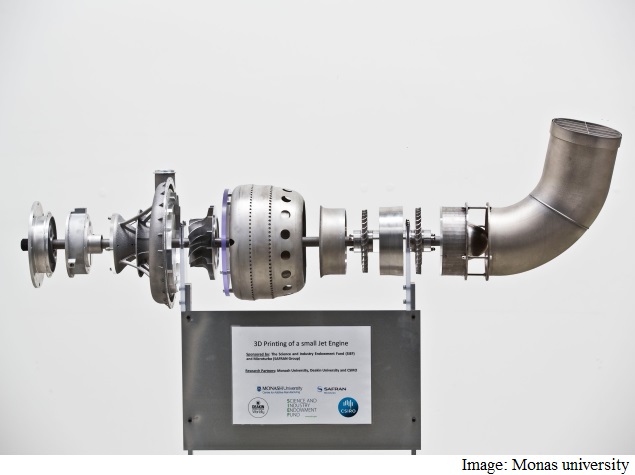- Home
- Laptops
- Laptops News
- Australian Researchers Unveil World's First 3D Printed Jet Engine
Australian Researchers Unveil World's First 3D-Printed Jet Engine

Engineers at Monash University and its commercial arm are making top-secret prototypes for Boeing Co, Airbus Group NV, Raytheon Co and Safran SA in a development that could be the saviour of Australia's struggling manufacturing sector.
"This will allow aerospace companies to compress their development cycles because we are making these prototype engines three or four times faster than normal," said Simon Marriott, chief executive of Amaero Engineering, the private company set up by Monash to commercialise the product.
Marriott said Amaero plans to have printed engine components in flight tests within the next 12 months and certified for commercial use within the next two to three years.
Australia has the potential to corner the market. It has one of only three of the necessary large-format 3D metal printers in the world - France and Germany have the other two - and is the only place that makes the materials for use in the machine.
It is also the world leader in terms of intellectual property (IP) regarding 3D printing for manufacturing.
"We have personnel that have 10 years experience on this equipment and that gives us a huge advantage," Marriott told Reuters by phone from the Avalon Airshow outside Melbourne.
3D printing makes products by layering material until a three-dimensional object is created. Automotive and aerospace companies use it for producing prototypes as well as creating specialized tools, moldings and some end-use parts.
Marriott declined to comment in detail on Amaero's contracts with companies, including Boeing and Airbus, citing commercial confidentiality. Those contracts are expected to pay in part for the building of further large format printers, at a cost of around A$3.5 million ($2.75 million) each, to ramp up production of jet engine components.
3D printing can cut production times for components from three months to just six days.
Ian Smith, Monash University's vice-provost for research, said it was very different to the melting, moulding and carving of the past.
"This way we can very quickly get a final product, so the advantages of this technology are, firstly, for rapid prototyping and making a large number of prototypes quickly," Smith said. "Secondly, for being able to make bespoke parts that you wouldn't be able to with classic engineering technologies."
© Thomson Reuters 2015
For the latest tech news and reviews, follow Gadgets 360 on X, Facebook, WhatsApp, Threads and Google News. For the latest videos on gadgets and tech, subscribe to our YouTube channel. If you want to know everything about top influencers, follow our in-house Who'sThat360 on Instagram and YouTube.
Related Stories
- Galaxy S24 Series
- MWC 2024
- Apple Vision Pro
- Oneplus 12
- iPhone 14
- Apple iPhone 15
- OnePlus Nord CE 3 Lite 5G
- iPhone 13
- Xiaomi 14 Pro
- Oppo Find N3
- Tecno Spark Go (2023)
- Realme V30
- Best Phones Under 25000
- Samsung Galaxy S24 Series
- Cryptocurrency
- iQoo 12
- Samsung Galaxy S24 Ultra
- Giottus
- Samsung Galaxy Z Flip 5
- Apple 'Scary Fast'
- Housefull 5
- GoPro Hero 12 Black Review
- Invincible Season 2
- JioGlass
- HD Ready TV
- Laptop Under 50000
- Smartwatch Under 10000
- Latest Mobile Phones
- Compare Phones
- Huawei Pura 70 Pro
- Huawei Pura 70
- Vivo V30e
- Itel Super Guru 4G
- Huawei Pura 70 Pro+
- Huawei Pura 70 Ultra
- Tecno Camon 30 Premier 5G
- Motorola Edge 50 Fusion
- Asus ZenBook Duo 2024 (UX8406)
- Dell Inspiron 14 Plus
- Realme Pad 2 Wi-Fi
- Redmi Pad Pro
- Cult Shock X
- Fire-Boltt Oracle
- Samsung Samsung Neo QLED 8K Smart TV QN800D
- Samsung Neo QLED 4K Smart TV (QN90D)
- Sony PlayStation 5 Slim Digital Edition
- Sony PlayStation 5 Slim
- Voltas 1.5 Ton 3 Star Split AC (183 Vectra Elegant 4503545)
- Hitachi 1.5 Ton 5 Star Inverter Split AC (RAS.G518PCBISF)
















